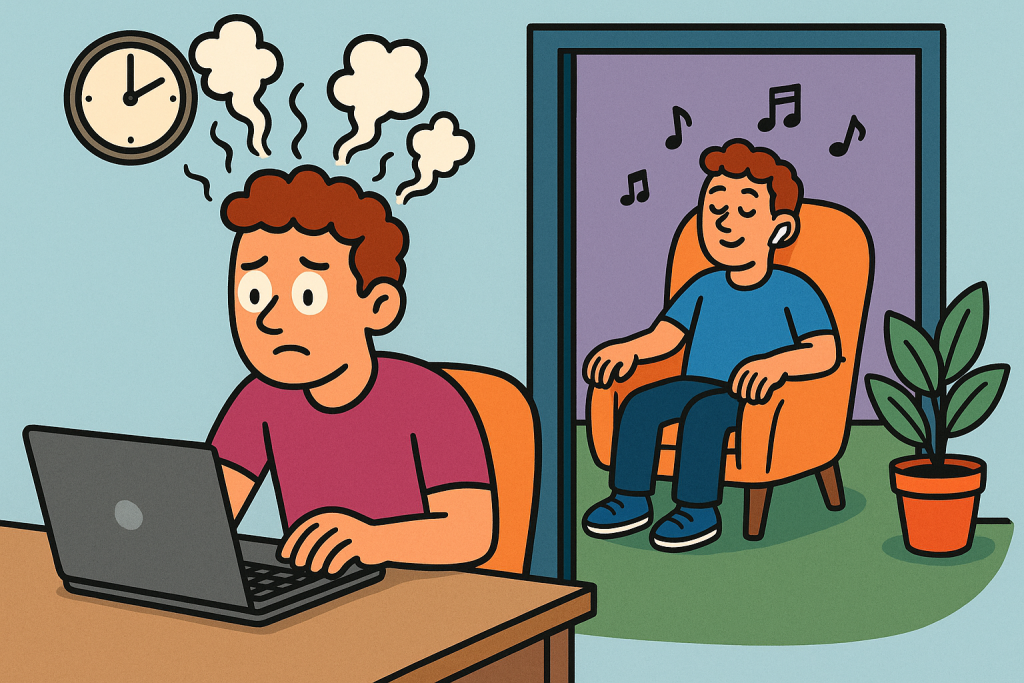Mental fatigue hits us hard. What if we treated our brains like athletes and adopted a cognitive cooldown routine? This guide explores emerging strategies—grounded in science—to decompress, reset, and return sharper than ever.

Why “cognitive cooldown” matters
A cognitive cooldown is a deliberate sequence of activities designed to reduce mental fatigue, reset attention, and improve emotional balance. Just like post-workout stretches help muscles, these practices help the brain recover from intensive focus or stress.
- Decision fatigue, the decline in decision quality after sustained mental effort, has real-world impacts—think slipping dinner choices or burnout in professionals.
- Directed attention fatigue occurs when we resist distractions over time; we lose focus and irritability rises.
- Mental breaks are already shown to replenish cognitive resources, both in office settings and creative tasks.
The takeaway: cognitive rest isn’t optional—it’s essential for productivity, mental health, and long-term thinking.
3 hot trends shaping cognitive cooldowns
- Brain + Body recovery
Exercise does more than help muscles—it temporarily enhances memory, working memory, and alertness. Even 10 minutes of light aerobic activity post-session can significantly improve focus . - Nature exposure & attention restoration
According to Attention Restoration Theory, nature provides “soft fascination” that restores directed attention—useful for digital fatigue recovery. - Brain Endurance Training (BET)
Emerging sport-science approaches combine cognitive tasks with physical exertion, enhancing resistance to mental fatigue over time.
A step-by-step cognitive cooldown routine
Crafted for desk workers, creatives, or anyone dealing with high mental load:
1. Transition with light movement (5 min)
- Take a brisk walk around the block or do light stretching.
- The goal: gently reduce tension while elevating mood and alertness.
Exercise before or after can both aid recovery; studies show 10 min of light movement helps cognitive rebound.
2. Practice breath awareness (3 min)
- Sit comfortably. Breathe in for 4 counts, hold 4, exhale 4 (box breathing).
- Enhances parasympathetic activation and reduces stress.
3. Engage in mental undemanding tasks (5–10 min)
- Try coloring, doodling, or sorting photos—activities that use “involuntary attention.”
- These offer “soft fascination” and aid in cognitive recovery.
4. Nature break or green screens (5–10 min)
- Preferably outdoors with greenery; if not, use nature videos or VR.
- Restored attention from natural scenes is supported by research.
5. Quick mindfulness or guided imagery (3–5 min)
- Focus on bodily sensations or a calm image; use an app if needed.
- Meditation and similar practices improve mental flexibility and reduce automatic stress responses.
6. Simple rewarding ritual (1–2 min)
- Enjoy a sip of flavored water, pet your cat, or reflect on a small win—activate reward circuits to boost mood.
Total time: ~20–30 minutes. You can adjust—longer breaks for heavy mental work, shorter for quick resets.
How this helps your brain
- Restores attention and executive control.
Directed attention recovers during low-effort, pleasurable tasks like nature walks or sketching . - Reduces stress and sympathetic activation.
Mental downtime helps rebalance nervous systems after overload . - Enhances working memory post-exercise.
Even brief aerobic activity improves response times on demanding tasks. - Builds resilience toward mental fatigue.
Repeated BET-style recovery can increase resistance to future stress and fatigue.
Tips for integrating cognitive cooldowns
- Schedule them: After 60–90 mins of deep work, reserve 20–30 mins for cooldown.
- Personalize: Nature enthusiasts might step outside; others could favor art or apps.
- Track impact: Note mood, clarity, or energy pre- and post-routine.
- Scale up: Once daily practice is habitual, try cognitive warm-ups before heavy tasks—like short breathing or mobile puzzles.
Future trends & tools
- VR nature escapes: Immersive environments that recreate restorative effects—gaining popularity in wellness programs .
- Wearable stress tracking: Smartwatches monitor HRV to suggest cooldown moments. Useful feedback loops.
- Gamified brain breaks: Apps like Peak or Lumosity prompt you with fun, low-stakes mental challenges between tasks.
Sample daily cooldown schedule
| Time | Activity | Purpose |
|---|---|---|
| 11:00 AM | 5 min walk + 3 min breathing | Physical reset + calm |
| 11:08 AM | 7 min coloring or doodling | Shifting attention gently |
| 11:15 AM | 8 min in green space or video | Nature-based restoration |
| 11:23 AM | 4 min guided meditation | Mental clarity and stress reduction |
| 11:27 AM | 3 min treat/time with reward action | Reward-system activation; mental satisfaction |
Final thoughts
A structured cognitive cooldown is more than a break—it’s a bridge from mental exertion to clarity. Combining movement, mindfulness, low-demand mental tasks, and nature-based restoration creates a holistic recovery toolkit with real cognitive benefits. It’s not just emerging—it’s essential. Implementing even a few of these steps can improve focus, decision quality, and workplace resilience.
References
- Cox, A. E., & Suzuki, W. (2023). Effects of Mindful Physical Activity on Perceived Exertion and Psychological Outcomes. Frontiers in Psychology. Retrieved from https://www.frontiersin.org
- Herbert, C. (2025). Exercising4Cognition: Can Short Bouts of Aerobic Exercise Improve Cognitive Performance in Healthy Adults? Healthcare, 13(4), Article 368. Retrieved from https://doi.org
- Sport & Active Recovery Editorial Team. (2024). Psychological Benefits of Cool‑Downs after Intense Workouts. Aim7. Retrieved from https://www.aim7.com






